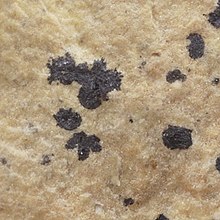Wattersite
Wattersite is a rare mercury chromate mineral with the formula Hg+14Hg+2Cr+6O6.[1] It occurs in association with native mercury and cinnabar in a hydrothermally altered serpentinite.[2] It was first described from Clear Creek claim, San Benito County, California, USA in 1961.[3] It was named to honor Californian mineral collector Lucius "Lu" Watters.[2]
| Wattersite | |
|---|---|
 Black crystals of wattersite with yellowish zones of edgarbaileyite. Locality: Clear Creek claim (Clear Creek Mine), Picacho Peak, New Idria District, Diablo Range, San Benito Co., California, USA. Dimensions: 6.6 cm x 4.8 cm x 4.1 cm | |
| General | |
| Category | Chromate mineral |
| Formula (repeating unit) | Hg+14Hg+2Cr+6O6 |
| Strunz classification | 7.FB.15 |
| Dana classification | 35.4.2.1 |
| Crystal system | Monoclinic |
| Unit cell | 859.81 ų |
| Identification | |
| Color | Dark red-brown to black |
| Crystal habit | Prismatic, aggregates, massive |
| Twinning | [001], contact twins on {100} |
| Cleavage | None |
| Fracture | Conchoidal |
| Tenacity | Brittle |
| Mohs scale hardness | 4.5 |
| Luster | Sub-Metallic |
| Streak | Brick red |
| Diaphaneity | Opaque |
| Specific gravity | 8.91 |
| Optical properties | Biaxial |
| Refractive index | nα = 2.440 - 2.520 nγ = 2.700 - 2.860 |
| Birefringence | δ = 0.260 - 0.340 |
| Pleochroism | Visible |
| Dispersion | r > v strong |
| References | [1][2] |
References
- "Wattersite". MinDat. Retrieved 29 April 2017.
- Handbook of Mineralogy
- Roberts, Andrew C.; Bonardi, Maurizio; Erd, Richard C.; Criddle, Alan J.; Le Page, Yvon (1991). "Wattersite Hg+14Hg+2Cr+6O6 a new mineral from the Clear Creek claim San Benito Country, California". The Mineralogical Record. 22: 269–272.
This article is issued from Wikipedia. The text is licensed under Creative Commons - Attribution - Sharealike. Additional terms may apply for the media files.